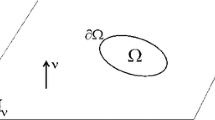Abstract
The stress intensity vector K i is defined as the limiting behaviour of the stress near the tip of a crack, the stress components being proportional to r −1/2 for any external loading. Internal stresses caused by dislocations show the same power dependence at the crack tip; the stress intensity associated with a loading can thus be screened (or amplified) by a plastic zone. Since for any particular specimen and crack geometry the stress intensity vector must be a functional of the loading and screening which are of vectorial character (lines of forces f i or dislocations with a Burgers vector b i) one can define two tensorial weight functions, one for screenings, D si(x, a), and one for forces, F si(x, a), so that the stress intensity K s can be found by integration over the product of weight functions and dislocation or force density. In order to find the weight functions the displacement field and the Airy stress vector must be known for some, completely arbitrary, loading or screening.
Zusammenfassung
Der Spannungsintensitätsvektor K i wird als das Verhalten der Spannungskomponenten in der Nahe der Rißspitze definiert. Fur beliebige äussere Belastung sind alle Spannungskomponenten proportional zu r −1/2. Innere, von Versetzungen verursachte Spannungen zeigen dasselbe Verhalter; deswegen kann die Spannungsintensität einer Belastung durch eine plastische Zone vermindert (order vergrössert) werden. Fur eine gewählte Probengeometrie und Rißanordnung muss der Spannungsintensitätsvektor ein Funktional von Belastung und Versetzungsabschirmung sein, die beide vektoriellen Charakter haben, da es sich um Linienkräfte der Stärke f i oder Versetzungen mit Burgersvektor b i handelt. Deshalb lassen sich zwei tensorielle Gewichtsfunktionen D si(x, a) und F si(x, a) für Versetzungen und Belastungen definieren, sodass die Spannungsintensitat K s als Integral über das Produkt von Gewichtsfunktionen und Versetzungs- oder Kraftdichte gefunden werden kann. Zur Berechnung der Gewichtsfunktionen muss das Verschiebungsfeld und der Airy-Spannungsvektor für irgendeine Verteilung von Kräften und Versetzungen bekannt sein.
Résumé
Les contraintes à l'extrémité d'une fissure varient comme K i r−1/2 quel que soit le mode de chargement, le facteur d'intensité des contraintes K i correspondant à la limite de % MathType!MTEF!2!1!+-% feaafiart1ev1aaatCvAUfeBSjuyZL2yd9gzLbvyNv2CaerbuLwBLn% hiov2DGi1BTfMBaeXatLxBI9gBaerbd9wDYLwzYbItLDharqqtubsr% 4rNCHbGeaGqiVu0Je9sqqrpepC0xbbL8F4rqqrFfpeea0xe9Lq-Jc9% vqaqpepm0xbba9pwe9Q8fs0-yqaqpepae9pg0FirpepeKkFr0xfr-x% fr-xb9adbaqaaeGaciGaaiaabeqaamaabaabaaGcbaWaaOaaaeaaca% aIYaGaeqiWdaNaamOCaaWcbeaaaaa!3978!\[\sqrt {2\pi r} \]ωi2 quand r tend vers 0. Les contraintes internes liées à la présence de dislocations varient de la même façon à la pointe de la fissure. La présence d'une zone plastique peut diminuer ou augmenter le facteur d'intensité des contraintes de K i à K s. Pour chaque type d'éprouvette, K s est une fonctionelle du chargement et de l'écrantage (grandeurs vectorielles du type ligne de force f i our dislocations de vecteur de Burgers b i). On peut définir deux fonctions de pondération tensorielles, une par l'écrantage D si (x, a). Ks est obtenu par intégration du produit de la fonction de pondération par la densité de dislocations ou de forces. Afin de déterminer ces fonctions, le champ de déplacement et les vecteurs contrainte d'Airy doivent être calculés pour un chargement ou un écrantage arbitraires.
Similar content being viewed by others
References
B.S.Majumdar and S.J.Burns, Acta Metallurgica 29 (1981) 579.
J.C.M.Li, in Dislocation Modelling of Physical Systems (edited by M.F.Ashby, R.Bullough, C.S.Hartley and J.P.Hirth) Pergamon Press, Oxford (1981) 498.
S.M.Ohr, Materials Science Engineering 72 (1985) 1.
P.Neumann, Z. Metallkunde 75 (1984) 790.
B.A. Bilby, A.H. Cottrell and H. Swinden, Proceedings, Royal Society London A272 (1963).
S.J.Chang and S.M.Ohr, Journal of Applied Physics 52 (1981) 7174.
S.J.Chang and S.M.Ohr, in Dislocation Modelling of Physical Systems (edited by M.F.Ashby, R.Bullough, C.S.Hartley and J.P.Hirth) Pergamon Press, Oxford (1981) 23.
J.Weertman, Acta metallurgica 32 (1984) 536, 574.
D.J.Bacon, D.M.Barnett and R.O.Scattergood, Progr. Materials Science 23 (1978) 51.
J.D.Eshelby, Philosophical Transactions A 244 (1951) 87.
J.Sinclair and J.P.Hirth, Journal of Physics F: Metal Physics 5 (1975) 236.
R.J.Asaro, Journal of Physics F: Metal Physics 5 (1975) 2249.
H.F.Bueckner. ZAMM 50 (1970) 529.
E.Kroener, Kontinuumstheorie der Versetzungen und Eigenspannungen, Springer, Berlin (1958).
T.Mura, Philosophical Magazine 8 (1967) 843.
J.A.Simmons and R.Bullough, in Fundamental Aspects of Dislocation Theory (edited by J.A.Simmons, R.deWit and R.Bullough), vol. II, National Bureau of Standards, Washington (1970) 89.
C.Teodusiu, Elastic Models of Crystal Defects, Springer, Berlin (1982).
G.Colonetti, Atti Accad. Naz. Lincei 24 (1915) 404.
B.A.Bilby and J.D.Eshelby, in Fracture (edited by H.Liebowitz), vol. I Academic Press, New York (1969) 99.
G.R.Irwin, Fracture, Handbuch der Physik, Vol. VI, Springer, Berlin (1958).
A.N.Stroh, Philosophical Magazine 3 (1958) 625.
N.J.Altiero and S.D.Gavazza, Journal of Elasticity 10 (1980) 1.
X.R.Wu and J.Carlsson, Journal of the Mechanics and Physics of Solids 31 (1983) 485.
J.Rice. International Journal Solid Structures 8 (1972) 751.
D.M.Barnett and R.J.Asaro, Journal of the Mechanics and Physics of Solids 20 (1972) 353.
J.R.Rice, International Journal Solids Structures 21 (1985) 781.
J.R.Rice, Journal of Applied Mechanics 52 (1985) 571.
J.R. Rice and Huajian Gao, Journal of Applied Mechanics submitted.
H.O.K.Kirchner and G.Michot, Materials Science Engineering 79 (1986) 169.
Author information
Authors and Affiliations
Rights and permissions
About this article
Cite this article
Kirchner, H.O.K. Description of loadings and screenings of cracks with the aid of universal weight functions. Int J Fract 31, 173–181 (1986). https://doi.org/10.1007/BF00018926
Received:
Revised:
Issue Date:
DOI: https://doi.org/10.1007/BF00018926




